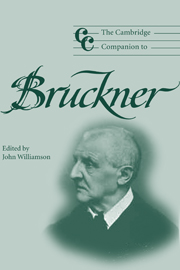Book contents
- Frontmatter
- Part I Background
- Part II Choral music
- Part III The symphonist
- 7 The Brucknerian symphony: an overview
- 8 Bruckner's symphonies – a reinterpretation: the dialectic of darkness and light
- 9 Programme symphony and absolute music
- 10 Bruckner editions: the revolution revisited
- 11 Bruckner and the symphony orchestra
- 12 Between formlessness and formality: aspects of Bruckner's approach to symphonic form
- 13 Formal process as spiritual progress: the symphonic slow movements
- 14 Bruckner and harmony
- Part IV Reception
- Notes
- Select bibliography
- Index
8 - Bruckner's symphonies – a reinterpretation: the dialectic of darkness and light
from Part III - The symphonist
Published online by Cambridge University Press: 28 September 2011
- Frontmatter
- Part I Background
- Part II Choral music
- Part III The symphonist
- 7 The Brucknerian symphony: an overview
- 8 Bruckner's symphonies – a reinterpretation: the dialectic of darkness and light
- 9 Programme symphony and absolute music
- 10 Bruckner editions: the revolution revisited
- 11 Bruckner and the symphony orchestra
- 12 Between formlessness and formality: aspects of Bruckner's approach to symphonic form
- 13 Formal process as spiritual progress: the symphonic slow movements
- 14 Bruckner and harmony
- Part IV Reception
- Notes
- Select bibliography
- Index
Summary
This chapter attempts to tease out some of the extra-musical meanings in Bruckner's symphonies by seeking to understand how the sacred character of his music is constructed, and how religious thought, especially relating to the dualism darkness/light, may have influenced Bruckner's compositional practice. It is well known that both light and darkness have important sacred connotations. Light is associated with goodness, morality, and salvation. In contrast, darkness has connotations of immorality (especially lust), evil, and hell. Bruckner's early familiarity with conventions for signifying light can be seen in the Offertory of his Requiem of 1849. Immediately following an agitated setting of ‘ne absorbeat eas tartarus, ne cadant in obscurum’, the C minor of ‘tartarus’ is exchanged for C major for the words ‘sed signifer sanctus Michael repraesentet eas in lucem sanctam’. A similar change from minor to major occurs at the word ‘Lux’ in the Agnus Dei of the same work.
Life is associated with light – ‘the light of life’ – as death is with darkness (the ‘shadow of death’ being a common image). We find associations of C minor with death in the ‘funeral marches’ in the slow movements of the Fourth and the Sixth (its third theme). We can be certain about what the climax of the Adagio of the Seventh represented for Bruckner, since the ‘Non confundar’ theme of his Te Deum is quoted, and he described the beginning of the coda as ‘funeral music for the Master’.
- Type
- Chapter
- Information
- The Cambridge Companion to Bruckner , pp. 92 - 107Publisher: Cambridge University PressPrint publication year: 2004



